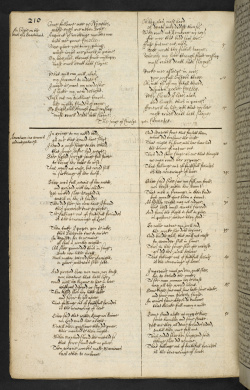Palamon and Arcite, Part 2
Historical Records
BL Add. MS 26737
A song entitled "An Elegie on the death of a Sweetheart" and followed by an attribution to Edwards and the note "The song of Emelye", is preserved in a seventeenth-century manuscript:
- British Library Add. MS 26737, fo.106v, reproduced by permission.
Jones, The Arbour of Amorous Devices (1597)
A printed version appeared in Richard Jones, The Arbour of Amorous Devices (1597, STC 3631), sigs. B1r-v, under the title "A Lady's Complaint for the Loss of Her Love". See the Open-Access version of EEBO-TCP:
A Ladies complaint for the losse of her Loue.
COme follow me you Nymphes,
Whose eyes are neuer drie,
Augment your wayling number nowe
With me poore Emelie.
Giue place ye to my plaintes,
Whose ioyes are pincht with paines
My loue, alas through foule mishap,
Most cruell death hath slaine,
What wight can wel, alas,
my sorrowes now indite?
I waile & want my new desire
I lack my new delite,
Gush out my trickling teares,
Like mighty floods of raine,
My Knight alas, through foule mishap
Most cruell death hath slaine.
Oh hap alas most hard,
Oh death why didst thou so?
Why could not I embrace my ioy,
for me that bid such woe?
False Fortunu out, alas,
Woe worth thy subtill traine,
Whereby my loue through foule mishap,
Most cruell death hath slaine.
Rock me a sleepe in woe,
You wofull Sisters three,
Oh cut you off my fatall threed,
Dispatch poore Emelie.
Why should I liue, alas,
And linger thus in paine?
Farewell my life, sith that my loue
Most cruell death hath slaine. Finis.
Theatrical Provenance
Performed at Christ Church, Oxford before the Queen on 04 September 1566.
Probable Genre(s)
Tragedy (Harbage); comedy (Stow); history (contemporary reference); romance (Wiggins).
Possible Narrative and Dramatic Sources or Analogues
Chaucer's The Knight's Tale.
References to the Play
Stow:
Comedies also and Tragedies were played in Christes Churche, where the Quéenes Highnesse dged. Among the whych, the Comedie entituled PalemonMisfortune at Oxford. and Arcet, made by Maister Edwards of the Quéenes Chap∣pel, had suche tragicall successe as was lamentable: For at that time by the fall of a wall and a payre of staires, & great presse of the multitude, thrée men were slaine (1130, EEBO-TCP (Open-Access))
Critical Commentary
<Summarise any critical commentary that may have been published by scholars. Please maintain an objective tone!>
For What It's Worth
<Enter any miscellaneous points that may be relevant, but don't fit into the above categories. This is the best place for highly conjectural thoughts.>
Works Cited
Site created and maintained by David McInnis, University of Melbourne; updated 19 April 2017.
